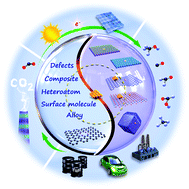Redox catalysis, including photocatalysis and (photo)electrocatalysis, may alleviate global warming and energy crises by removing excess CO2 from the atmosphere and converting it to value-added resources. Nano-to-atomic two-dimensional (2D) materials, clusters and single atoms are superior catalysts because of their engineerable ultrathin/small dimensions and large surface areas and have attracted worldwide research interest. Given the current gap between research and applications in CO2 reduction, our review systematically and constructively discusses nano-to-atomic surface strategies for catalysts reported to date. This work is expected to drive and benefit future research to rationally design surface strategies with multi-parameter synergistic impacts on the selectivity, activity and stability of next-generation CO2 reduction catalysts, thus opening new avenues for sustainable solutions to climate change, energy and environmental issues, and the potential industrial economy.
